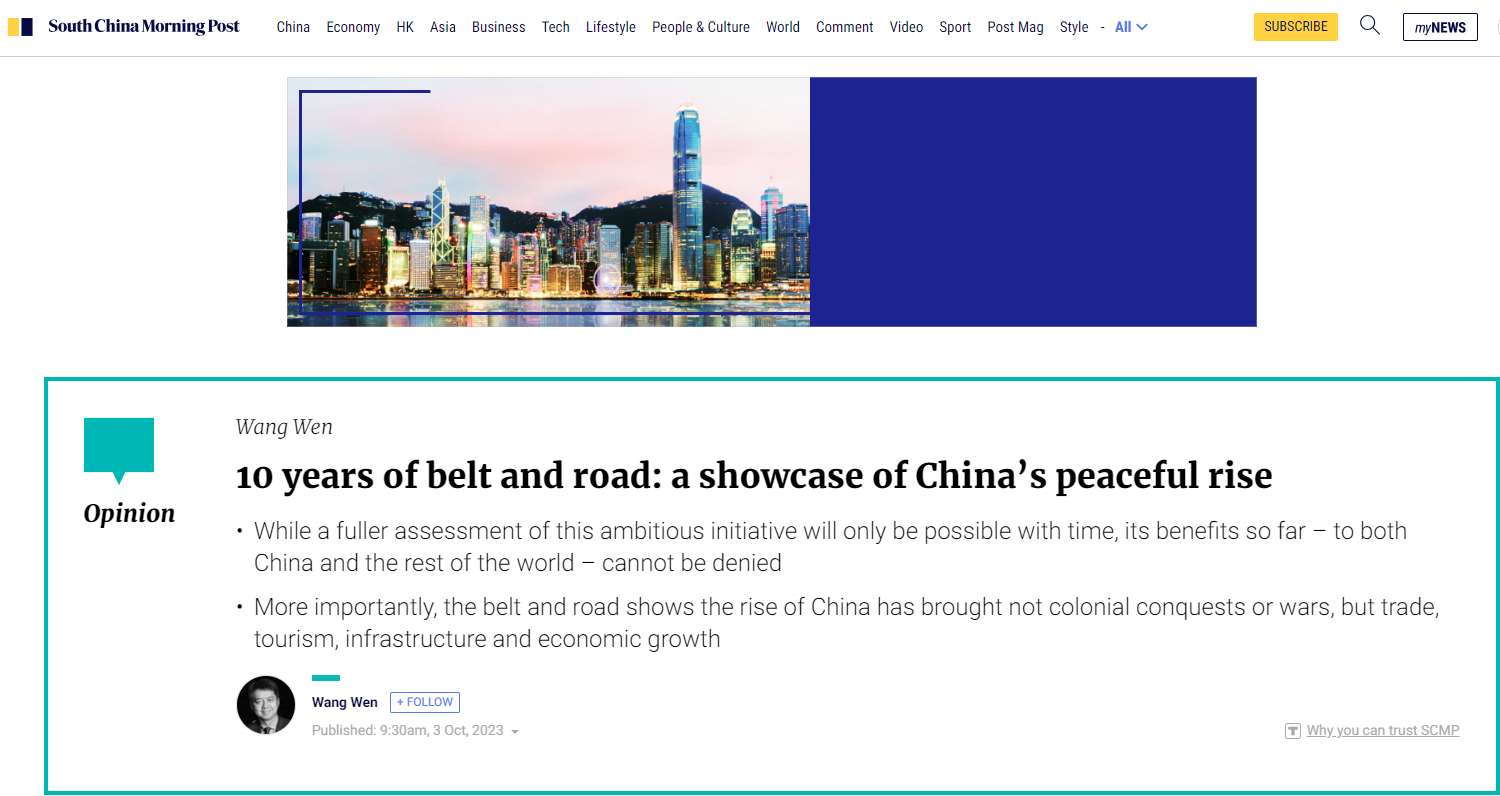LATEST INSIGHTS
Your Present Location: LATEST INSIGHTSWang Wen: 10 years of belt and road: a showcase of China’s peaceful rise
Source: SCMP Published: 2023-10-03

It’s been 10 years since the Belt and Road Initiative (BRI) was launched, and later this month, China will host the third Belt and Road Forum for International Cooperation in Beijing.
Journalists and scholars from around the world have been reflecting on the 10 years of the belt and road. Among those reflections, Western narratives that focus on certain individual cases or take a particular slant rate the belt and road poorly.
The initiative is arguably the first concept for global cooperation in the history of China’s 5,000-year-old civilisation that has both global strategic significance and a clear path for implementation. Over the past 10 years, the belt and road has revamped China’s international trade structure, which had previously been overly reliant on the West, and gradually promoted the rebalancing of China’s economic focus. It has also reshaped the world view of the Chinese and fostered a global perspective of openness.
To take a wider perspective, the changes the belt and road has brought to the world are even more valuable than the changes it has brought to China.
In fact, while the belt and road promotes the rebalancing of China’s economic and trade structure, it is also promoting changes to the pattern of international relations and global perspectives.
In terms of real development, the project has significantly improved people’s well-being overall, especially those in the non-Western world, while boosting their interconnectedness with China. As of now, more than 150 countries have signed BRI cooperation agreements with China.
In Africa, China has built more than 6,000km of railways, over 10,000km of roads and multiple major infrastructure projects such as ports, airports, power stations, schools and hospitals. In the past 10 years, China’s annual outward foreign investment has averaged about US$150 billion, with more of its capital flowing to BRI countries.
According to a 2019 World Bank study, the Belt and Road Initiative is expected to add real income gains of between 1.2 and 3.4 per cent for countries along the route. A significant number of projects – including the Mombasa–Nairobi standard gauge railway, the China-Laos railway, and the Jakarta-Bandung high-speed railway – are completed and operational, to the benefit of the local communities.
The belt and road has provided an alternative development model for developing countries. In the past, developing nations often regarded the Washington Consensus as the only point of reference for their development path. The achievements of 10 years of belt and road show that the Chinese economic experience, which champions “infrastructure first”, is more suitable for up-and-coming countries.
More importantly, China’s capacity for infrastructure production and successes in trade investment, accompanied by an operation framework that ranges from planning and design to financing and operation, has enabled developing countries that have been trapped by a lack of technology and capital to catch up.
Ten years of belt and road cooperation has encouraged developing countries to strive for a better future, thereby improving the balance and fairness of the international community in technology, trade and rules.
Ten years of the belt and road have also forced Western countries to reflect on and adjust their own foreign strategies. The US, for example, has already cycled through several similar schemes since the launch of the belt and road – from the Trump administration’s initiatives promoting infrastructure construction and manufacturing to the Biden government’s leading role in the launch of the Build Back Better World plan – which has since morphed into the Partnership for Global Infrastructure and Investment – and more recently the economic corridor that connects India, the Middle East and the EU. All these are inspired by the BRI, but none can yet compete with it.
Objectively speaking, global governance led by the West has made historical contributions. But it has to be said that, in the nearly 80 years following the end of World War II, and especially since the end of the Cold War, the negative impact the West has had on the world far outweighs the positives.
Now that Western countries are making a greater effort to work more closely with developing countries, albeit in an attempt to compete with China, if these efforts actually bring benefits, then that is an unexpected surprise of the belt and road.
No matter how Western politicians, the media and think tanks vilify the initiative, they cannot cover up the basic fact that, when in a position of strength, China does not take the old path of aggression and expansion we see in the histories of Europe, the US, Japan and others.
The 10 years of the Belt and Road Initiative have proven that the rise of China has not brought colonial conquests, disasters and wars. Instead, it has brought the world trade, tourism, new infrastructure and economic growth. This is more than can be said for the Western countries’ rise to power.
Ten years is too soon to evaluate a grand strategy like the BRI. The belt and road has brought benefits thus far, but more time is needed for a more accurate assessment. We should wait 20, 30, 40 years or more – perhaps only then will the world appreciate the significance of the initiative, in the same way that we have come to admire the greatness of China’s reform and opening up.
Key Words: Wang Wen, BRI, Cooperation























































































 京公网安备 11010802037854号
京公网安备 11010802037854号





